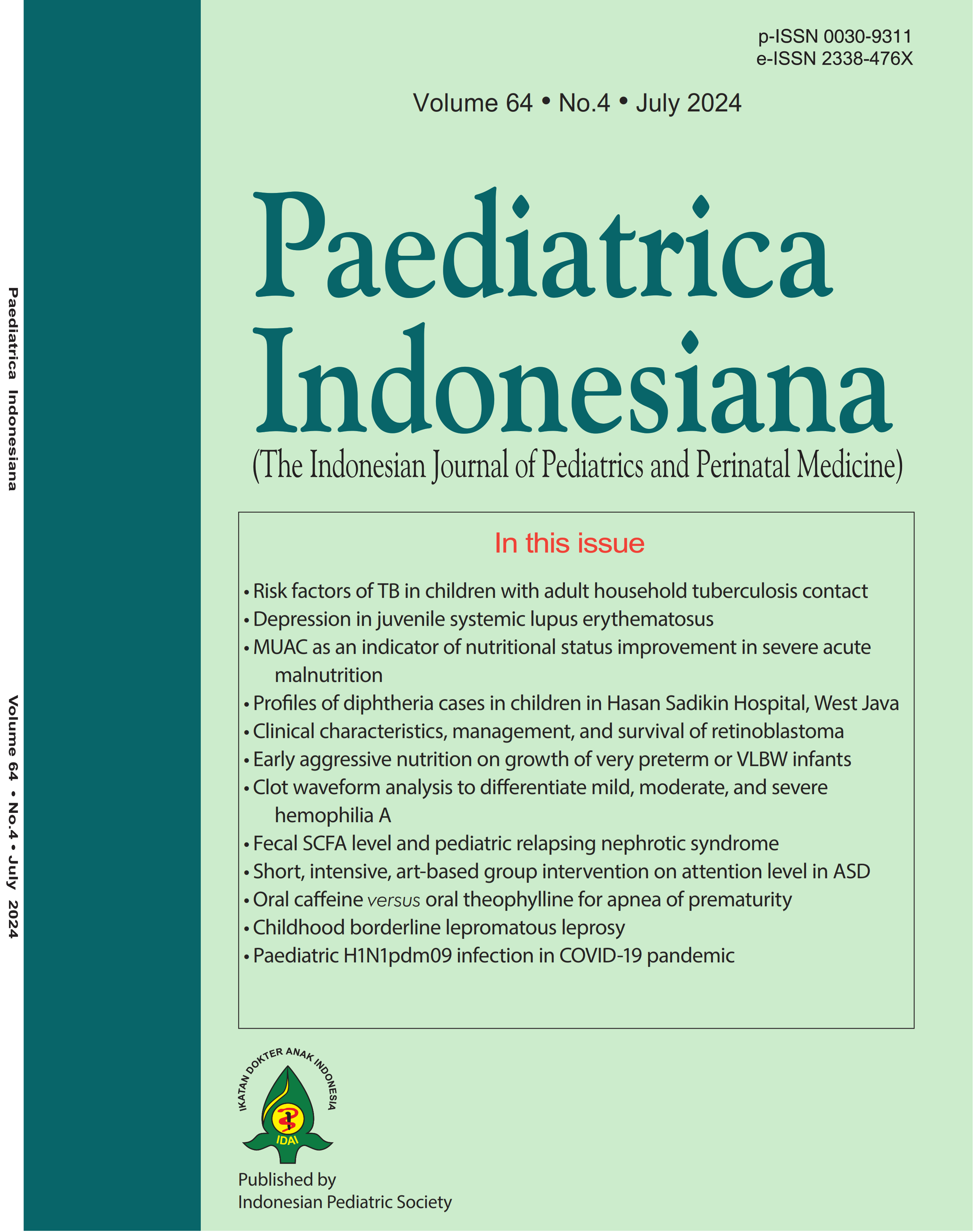Mid-upper arm circumference as an indicator of nutritional status improvement in children aged 6-59 months with severe acute malnutrition
Abstract
Background The prevalence of severe acute malnutrition (SAM) in Indonesia remains high, especially in children with pre-existing chronic disease. These children often present with conditions that could interfere with weight measurements, such as edema or organomegaly. Mid-upper arm circumference (MUAC) is a potential indicator of nutritional status improvement.
Objective To analyze the correlation between MUAC and body weight as parameters for nutritional improvement in children with SAM.
Methods We performed registry analysis of patients admitted to the Pediatric Ward, Cipto Mangunkusumo Hospital, Jakarta, Indonesia from November 2016 to December 2020. We included children aged 6-59 months who were severely wasted (z-score <-3 on the WHO weight-for-height growth chart), had no conditions that could alter weight measurement, and had a 7-day minimum hospital stay. Patients with missing body weight and/or MUAC data were excluded. MUAC and weight increment between admission and discharge were analyzed using bivariate correlation and linear regression analyses.
Results Out of 4,746 pediatric inpatients, 1,996 presented with SAM. Of these, 124 were eligible for analysis. Subjects’ median age was 18 (IQR 11-32) months and median length of stay was 16 days (IQR 9-29 days). Weight increment (g/kg/day) and MUAC increment (mm/day) were independently and significantly correlated (P<0.001; Spearman’s rho=0.414). An adequate weight increment of 5-10 g/kg/day was equivalent to a MUAC increment of 0.319-0.439 mm/day (P<0.001; R=0.374).
Conclusion MUAC increment has a moderate positive correlated with weight increment. MUAC is a useful parameter of nutritional status improvement in SAM patients, especially in patients with conditions that could interfere with weight measurement.
References
2. Ahmed T, Hossain M, Mahfuz M, Choudhury N, Hossain MM, Bhandari N, et al. Severe acute malnutrition in Asia. Food Nutr Bull. 2014;35(2Suppl):S14–26. DOI: https://doi.org/10.1177/15648265140352S103
3. Ministry of Health, Republic of Indonesia. Laporan Nasional Riskesdas 2018. [cited 2022 Jan 17] Jakarta: Ministry of Health, Republic of Indonesia; 2018. p. 101-103. Available from: https://repository.badankebijakan.kemkes.go.id/id/eprint/3514/.
4. Sultana T, Karim MN, Ahmed T, Hossain MI. Assessment of under nutrition of Bangladeshi adults using anthropometry: can body mass index be replaced by mid-upper-arm-circumference? PLoS One. 2015;10:e0121456. DOI: https://doi.org/10.1371/journal.pone.0121456
5. Goossens S, Bekele Y, Yun O, Harczi G, Ouannes M, Shepherd S. Mid-Upper Arm circumference based nutrition programming: evidence for a new approach in regions with high burden of acute malnutrition. PLoS One. 2012;7:e49320. DOI: https://doi.org/10.1371/journal.pone.0049320
6. Briend A, Dykewicz C, Graven K, Mazumder RN, Wojtyniak B, Bennish M. Usefulness of nutritional indices and classifications in predicting death of malnourished children. Br Med J. 1986;293:373–5. DOI: https://doi.org/10.1136/bmj.293.6543.373
7. Mwangome MK, Fegan G, Prentice AM, Berkley JA. Are diagnostic criteria for acute malnutrition affected by hydration status in hospitalized children? A repeated measures study. Nutr J. 2011;10:92. DOI: https://doi.org/10.1186/1475-2891-10-92
8. Burrell A, Kerac M, Nabwera H. Monitoring and discharging children being treated for severe acute malnutrition using mid-upper arm circumference: secondary data analysis from rural Gambia. Int Health. 2017;9:226–33. DOI: https://doi.org/10.1093/inthealth/ihx022
9. Binns P, Dale N, Hoq M, Banda C, Myatt M. Relationship between mid upper arm circumference and weight changes in children aged 6–59 months. Arch Public Health. 2015;73:54. DOI: https://doi.org/10.1186/s13690-015-0103-y
10. Brambilla P, Roland-Cachera MF, Testolin C, Briend A, Salvatoni A, Testolin G, et al. Lean mass of children in various nutritional states: comparison between dual-energy x-ray absorptiometry and anthropometry. Ann N Y Acad Sci. 2000;904:433–6. DOI: https://doi.org/10.1111/j.1749-6632.2000.tb06497.x
11. World Health Organization. Guidelines for an Integrated Approach to the Nutritional Care of HIV-Infected Children (6 Months-14 Years) [Internet]. 2009. Available from: http://www.who.int/nutrition/publications/hivaids/ 9789241597524/en/
12. Burza S, Mahajan R, Marino E, Sunyoto T, Shandilya C, Tabrez M, et al. Community-based management of severe acute malnutrition in India: new evidence from Bihar. Am J Clin Nutr. 2015;101:847–59. DOI: https://doi.org/10.18203/2320-6012.ijrms20184920
13. Phelan KPq, Lanusse C, van der Kam S, Delchevalerie P, Avril N, Hanson KE. Simplifying the response to childhood malnutrition: MSF’s experience with MUAC-based (and oedema) programming. [cited 2022 Jan 20]. Available from: https://api.semanticscholar.org/CorpusID:81531127.
14. Collins S. Treating severe acute malnutrition seriously. Arch Dis Child. 2007;92:453–61. DOI: https://doi.org/10.1136/adc.2006.098327
15. Kementerian Kesehatan Republik Indonesia, Direktorat Jenderal Kesehatan Masyarakat. Pedoman pencegahan dan tata laksana gizi buruk pada balita. Jakarta: Kemenkes RI; 2019. ISBN 978-602-416-525-3.
Copyright (c) 2024 Trivani Putri, Yosafat Lambang Prasetyadi, Naufal Arkan Abiyyu Ibrahim, Cut Nurul Hafifah

This work is licensed under a Creative Commons Attribution-NonCommercial-ShareAlike 4.0 International License.
Authors who publish with this journal agree to the following terms:
Authors retain copyright and grant the journal right of first publication with the work simultaneously licensed under a Creative Commons Attribution License that allows others to share the work with an acknowledgement of the work's authorship and initial publication in this journal.
Authors are able to enter into separate, additional contractual arrangements for the non-exclusive distribution of the journal's published version of the work (e.g., post it to an institutional repository or publish it in a book), with an acknowledgement of its initial publication in this journal.
Accepted 2024-08-27
Published 2024-08-27













